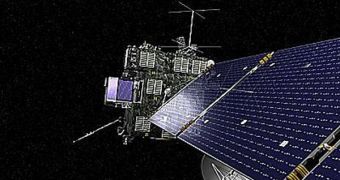On November 13, the European Space Agency's (ESA) Rosetta comet chaser will swing by our planet for the last time, before it begins the final segment of its ten-year journey to the outer reaches of the solar system. During its approach, it will provide astronomers with new data on the Earth-Moon system, before finally departing to study the comet 67/P Churyumov-Gerasimenko, ScienceDaily reports. Its first significant encounter with a celestial body will take place in July 2010, when it will come across the asteroid 21 Lutetia.
The final Earth-assist stage is required in order for the spacecraft to gain the correct inclination and speed for the rest of its journey. Thus far, the instrument has traveled a mind-boggling 4,500 million kilometers since it was launched, on March 2, 2004, aboard an Ariane 5 delivery system. As it will swirl past the Earth for the last time, it will fly over the island of Java, at a speed of about 13.3 kilometers per second. The gravity-assist stage of the flight will increase its velocity by more than 3.6 kilometers per second, in respect to the Sun.
The spacecraft is scheduled to meet the comet 67/P Churyumov-Gerasimenko in the early months of 2014. Once in its vicinity, it will drop a lander on the surface of the space rock, and then continue to pursue and study it for the next couple of years, as the “couple” makes its way towards the inner solar system again. Its mission is currently scheduled to conclude around December 2015, although an extension is not off the table yet.
The lander robot, Philae, is the first exploration device that will fire harpoons at the surface of the comet, so as to avoid bouncing off it. It will approach the rock at a speed of about one meter per second. After it fires two harpoons into 67/P, additional drills will lock it tightly in place. Philae's mission has three main objectives, the study of the comet's nucleus, determining its chemical composition and studying its activities and development over time. The thing about the lander is that no surface map of the comet exists, so the craft will have to make one, before landing.
ESA experts are hopeful that a place to land will be found, once the maps are analyzed. There are ten scientific instruments on Rosetta and its lander, including spectroscopes, spectrometers, ion-mass analyzers, and dust-analysis systems. The orbiter was named after the famous Rosetta Stone that helped experts understand Egyptian hieroglyphic writing, while the lander is named after the Nile island Philae, whose obelisk helped decipher the tablet.

 14 DAY TRIAL //
14 DAY TRIAL //